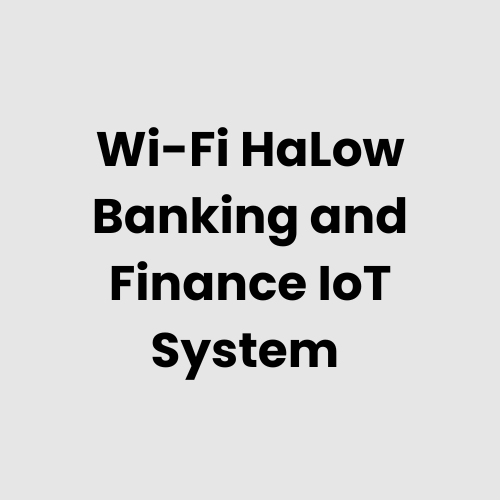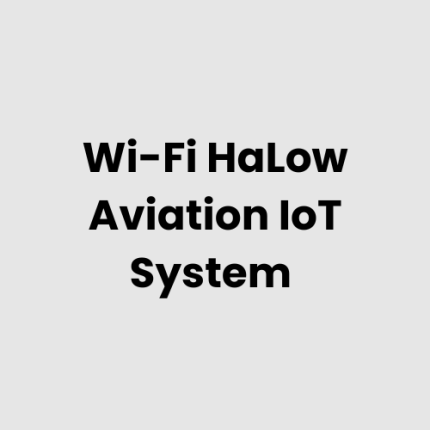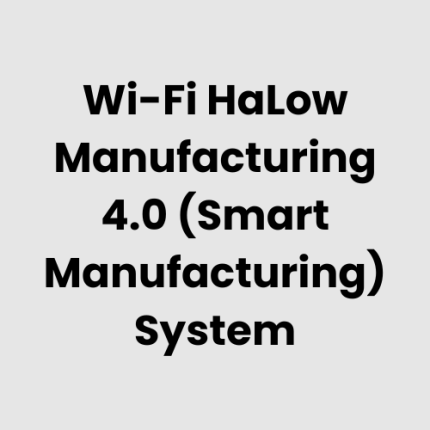Description
Wi-Fi HaLow Banking and Finance IoT System: Technical Architecture
The Wi-Fi HaLow Banking and Finance IoT System is designed to enhance the security, efficiency, and scalability of financial institutions by leveraging the long-range and low-power capabilities of Wi-Fi HaLow (IEEE 802.11ah). This system supports secure and reliable IoT connectivity for ATMs, point-of-sale (POS) terminals, digital payment systems, and various banking and finance operations.
The technical architecture of the system includes several key components that work together seamlessly to provide real-time data processing, secure transactions, and enhanced operational visibility:
- Connectivity Layer: At the core of this system is Wi-Fi HaLow, which provides low power and long-range communication, ideal for connecting IoT devices in remote or distributed locations, such as bank branches, ATMs, and POS terminals.
- IoT Device Layer: This layer includes various devices such as ATMs, POS systems, smart safes, and digital kiosks. These devices collect and transmit sensitive transaction data, customer interactions, and operational statistics.
- Data Collection and Processing Layer: Data from IoT devices is aggregated and processed at local servers or edge devices. This layer ensures that data can be analyzed and acted upon in real-time, supporting everything from fraud detection to operational optimization.
- Cloud Integration Layer: For deeper analysis, long-term storage, and broader scalability, data is sent to cloud platforms where advanced analytics, machine learning, and artificial intelligence can be applied to optimize financial services, enhance security, and predict customer needs.
- Security Layer: With the sensitive nature of financial data, robust encryption, authentication, and secure transmission protocols are enforced across the entire architecture to protect against data breaches, fraud, and cyber threats.
Hardware Components of the Wi-Fi HaLow Banking and Finance IoT System
The hardware of the Wi-Fi HaLow Banking and Finance IoT System is tailored to support a range of financial services operations, ensuring secure and seamless connectivity across all devices:
- Wi-Fi HaLow Routers and Gateways: These devices provide the foundation of the system’s network, ensuring secure and reliable long-range communication between IoT devices, including ATMs, POS systems, and smart safes.
- IoT Devices and Sensors: ATMs, POS terminals, biometric sensors, and video surveillance cameras are among the critical devices in this system. These devices facilitate secure transactions, monitor customer interactions, and detect fraud.
- Edge Computing Devices: These devices process data close to the source, providing real-time insights and reducing latency for faster decision-making. They are especially useful in locations where immediate action is required, such as for fraud detection or transaction approval.
- Local Servers: Local servers store and process data on-site, providing immediate analytics and ensuring that critical information is available to banking operations even during network outages.
- Security Devices: Hardware security modules (HSMs), encryption devices, and other security-focused hardware are included to ensure secure storage and transaction processing.
Physical Placement Considerations of the Hardware
The deployment of the Wi-Fi HaLow Banking and Finance IoT System requires careful placement of hardware to ensure maximum efficiency, coverage, and security:
- Wi-Fi HaLow Routers and Gateways: These should be strategically placed across banking facilities and ATMs to ensure that devices remain connected. Placement should avoid obstacles like walls and metal structures that may impede signal strength.
- IoT Devices (ATMs, POS terminals, etc.): ATMs, POS terminals, and other customer-facing devices should be placed in secure, easily accessible locations. They need to be accessible for customers but protected from tampering or theft.
- Sensors and Security Devices: Security devices such as biometric sensors, video surveillance cameras, and motion detectors should be placed in critical areas to monitor access points and ensure the security of financial transactions and customer interactions.
- Edge Devices: Edge devices should be placed close to the IoT devices they monitor to minimize latency and ensure real-time data processing. These devices must be housed in secure enclosures to protect against tampering and environmental factors.
Hardware Architecture of the Wi-Fi HaLow Banking and Finance IoT System
The system’s hardware architecture follows a multi-layered approach to ensure secure, scalable, and efficient operation:
- Wi-Fi HaLow Network: The core of the system is Wi-Fi HaLow, providing long-range, low-power connectivity to all devices, including ATMs, POS systems, biometric sensors, and video cameras.
- IoT Devices: ATMs, smart safes, POS terminals, biometric scanners, and cameras form the IoT layer. These devices generate data related to transactions, customer activity, and environmental conditions.
- Edge Computing Nodes: These local devices process data in real-time, reducing the need to transmit large amounts of data to central servers. They handle data collection, monitoring, and basic analytics.
- Local Servers: Local servers ensure that data can be processed and stored on-site, enabling rapid response times for transaction processing, fraud detection, and other critical functions.
- Cloud Platform: The cloud enables scalable data storage, advanced analytics, and integration with other banking systems, such as payment gateways and fraud detection systems.
- Security Systems: Robust security protocols, such as encrypted communication and secure data storage, are implemented to protect sensitive customer and transaction data across the entire system.
Deployment Considerations of the Wi-Fi HaLow Banking and Finance IoT System
Deploying the Wi-Fi HaLow Banking and Finance IoT System requires careful planning and attention to several key factors:
- Network Design: The placement of Wi-Fi HaLow routers and gateways must be optimized for coverage across the bank’s physical locations, including branches, ATMs, and remote terminals. Careful network design ensures that devices remain connected and data is transmitted securely.
- Security: Given the sensitive nature of financial data, the system must implement strong encryption, authentication, and secure data transmission. This includes securing access to IoT devices, servers, and cloud storage to prevent unauthorized access and data breaches.
- Scalability: The system should be designed with scalability in mind, allowing financial institutions to add new devices, sensors, and locations as needed without compromising performance or security.
- Integration with Existing Systems: The Wi-Fi HaLow Banking and Finance IoT System must be compatible with existing banking systems, such as transaction processing software, fraud detection systems, and customer relationship management (CRM) tools.
- Regulatory Compliance: The system must comply with financial industry regulations and standards, such as the Payment Card Industry Data Security Standard (PCI DSS) and the General Data Protection Regulation (GDPR), to ensure that all transactions and customer data are handled securely and legally.
List of Relevant Industry Standards and Regulations
- Payment Card Industry Data Security Standard (PCI DSS)
- General Data Protection Regulation (GDPR)
- Federal Financial Institutions Examination Council (FFIEC) Guidelines
- ISO/IEC 27001 (Information Security Management)
- ISO/IEC 20000-1 (IT Service Management)
- National Institute of Standards and Technology (NIST) Cybersecurity Framework
- Financial Action Task Force (FATF) Recommendations
- Electronic Funds Transfer Act (EFTA)
- Bank Secrecy Act (BSA) / Anti-Money Laundering (AML) Regulations
Local Server Version: Running with a Local Server
For certain applications, particularly those requiring real-time data processing or compliance with specific regulatory requirements, a local server-based deployment is beneficial. In this configuration, the system operates on-site with dedicated servers that manage and process sensitive financial data without relying on cloud connectivity.
- Real-Time Data Processing: Local servers ensure that financial transactions and customer data are processed instantly, supporting immediate responses for fraud detection, transaction approvals, and customer interactions.
- Secure Data Storage: Critical financial data is stored securely on-site, minimizing the risk of unauthorized access or data breaches. Local servers can be configured to meet specific data storage regulations, ensuring compliance with industry standards.
- Integration with Banking Infrastructure: Local servers can be easily integrated with existing banking systems, including ATMs, POS terminals, transaction processing software, and fraud detection systems, without requiring a cloud connection.
Cloud Integration and Data Management
The Wi-Fi HaLow Banking and Finance IoT System integrates seamlessly with cloud platforms to enhance data storage, scalability, and analytics:
- Cloud Storage: Financial institutions can store large amounts of transactional and customer data in the cloud, providing scalability and flexibility while ensuring that data is protected with high-level encryption.
- Advanced Analytics: The cloud enables sophisticated data analytics tools that can detect fraud, predict customer behavior, optimize resource allocation, and improve overall banking operations.
- Data Synchronization: Data collected from various banking devices, such as ATMs and POS terminals, is synchronized with the cloud for centralized processing and analysis. This ensures that financial data is always up-to-date and accessible to decision-makers in real time.
- Security and Compliance: Cloud platforms used for this system meet stringent security requirements, including encryption, access control, and regulatory compliance, to ensure that financial data is protected from unauthorized access and cyber threats.
GAO Case Studies of Banking and Finance IoT
USA Case Studies
- New York City, New York: A major financial institution in New York City adopted IoT-enabled smart ATMs to provide better monitoring and enhance transaction security. GAO Tek offers IoT solutions to improve financial service efficiency and safety. Explore IoT for financial security.
- San Francisco, California: A bank in San Francisco integrated IoT sensors into their data centers for real-time environmental monitoring, reducing energy consumption by 15%. GAO Tek’s IoT systems help optimize resource management in financial facilities. Learn about IoT for data center efficiency.
- Chicago, Illinois: A Chicago-based credit union deployed IoT-enabled smart card readers for contactless payments, streamlining customer transactions. GAO Tek provides seamless IoT solutions for payment systems in the banking sector. Explore IoT for payments.
- Miami, Florida: Financial institutions in Miami used IoT-connected devices to track cash flow and improve cash management. GAO Tek offers IoT tools that assist in optimizing cash handling and logistics. Discover IoT for cash management.
- Dallas, Texas: A financial services firm in Dallas incorporated IoT-based surveillance systems to enhance security in their facilities, reducing fraud risks. GAO Tek delivers robust IoT solutions for enhancing security in the banking sector. Learn more about IoT in financial security.
- Los Angeles, California: A Los Angeles-based investment firm employed IoT sensors to monitor asset performance in real-time, improving portfolio management. GAO Tek offers innovative IoT solutions to track and analyze financial assets. Explore IoT for asset tracking.
- Washington, D.C.: A government financial agency in Washington, D.C. deployed IoT to monitor transaction trends and detect anomalies, ensuring compliance with regulations. GAO Tek’s IoT solutions support regulatory compliance in financial services. Understand IoT for financial compliance.
- Boston, Massachusetts: In Boston, a fintech company used IoT devices to track ATM health and optimize repair schedules, minimizing service disruption. GAO Tek’s solutions help streamline ATM maintenance for uninterrupted service. Discover IoT for ATM monitoring.
- Atlanta, Georgia: A financial institution in Atlanta integrated IoT-enabled sensors into their branches for monitoring customer traffic, enhancing service efficiency. GAO Tek provides IoT solutions that improve customer experience in the banking sector. Learn about IoT for customer service.
- Phoenix, Arizona: A major bank in Phoenix leveraged IoT to streamline branch security by deploying smart sensors that monitored entry points. GAO Tek delivers advanced IoT solutions for securing banking premises. Explore IoT for security in banking.
- Seattle, Washington: A fintech startup in Seattle utilized IoT for real-time monitoring of digital wallets, improving transaction security and user experience. GAO Tek offers tools to enhance digital wallet security using IoT. Discover IoT for digital wallet security.
- Houston, Texas: A financial institution in Houston deployed IoT-based environmental sensors to monitor and control indoor climates, cutting energy costs. GAO Tek’s IoT systems enable businesses to optimize energy efficiency in financial environments. Learn more about energy-efficient IoT solutions.
- Denver, Colorado: A financial services company in Denver incorporated IoT to improve the accuracy of fraud detection, reducing false positives. GAO Tek provides IoT solutions that enhance fraud detection systems in finance. Explore IoT for fraud detection.
- Minneapolis, Minnesota: Banks in Minneapolis used IoT-based sensors to track and authenticate customer interactions, enhancing secure login processes. GAO Tek offers IoT solutions that improve banking authentication systems. Discover IoT for secure authentication.
- Indianapolis, Indiana: A regional bank in Indianapolis utilized IoT-based predictive analytics to better understand customer behavior and customize services. GAO Tek supports the banking sector with advanced IoT analytics tools. Learn more about predictive analytics in banking.
Canada Case Studies
- Toronto, Ontario: A major bank in Toronto adopted IoT sensors to monitor the performance of their financial servers, ensuring continuous uptime. GAO Tek provides monitoring systems that enhance the reliability of financial infrastructures. Explore IoT for financial server monitoring.
- Vancouver, British Columbia: In Vancouver, a credit union used IoT-connected mobile devices to enhance customer engagement and improve mobile banking features. GAO Tek offers IoT solutions that help financial institutions optimize mobile services. Discover IoT for mobile banking.
Navigation menu for Wi-Fi HaLow
- Wi-Fi HaLow Gateways/Routers
- Wi-Fi HaLow End Devices
- Wi-Fi Halow – Cloud, Server, PC & Mobile Systems
- Wi-Fi HaLow Accessories
Navigation Menu for IoT
- LORAWAN
- Wi-Fi HaLow
- Z-WAVE
- BLE & RFID
- NB-IOT
- CELLULAR IOT
- GPS IOT
- IOT SENSORS
- EDGE COMPUTING
- IOT SYSTEMS
Our products are in stock and can be shipped anywhere in the continental U.S. or Canada from our local warehouse. For any further information, please fill out this form or email us.
We are looking for partners. For more information on partnering with GAO, please visit Partner with GAO Tek Inc. It lists various ways to partner with GAO, such as OEM Partnerships, Technology Integration, Distribution and Reselling Opportunities, Presenting at the Leading Event TekSummit, Joint R&D Projects, Training and Consulting Services, Industry-Specific Collaborations, Research and Academic Partnerships.



